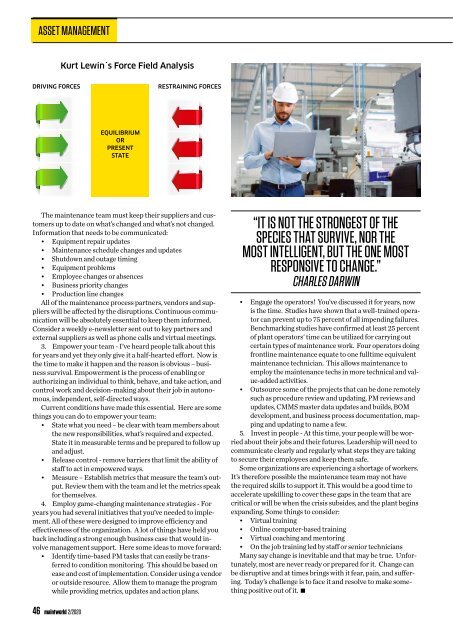Maintworld 2/2020
To the Bravest Asset Managers – Living and working in the post-corona era ADAPTIVE ALIGNMENT - DATA-DRIVEN SPARE PARTS MANAGEMENT - MANAGING THE CRISIS EFFECTIVELY
To the Bravest Asset Managers – Living and working in the post-corona era
ADAPTIVE ALIGNMENT - DATA-DRIVEN SPARE PARTS MANAGEMENT - MANAGING THE CRISIS EFFECTIVELY
Create successful ePaper yourself
Turn your PDF publications into a flip-book with our unique Google optimized e-Paper software.
ASSET MANAGEMENT<br />
Kurt Lewin´s Force Field Analysis<br />
DRIVING FORCES<br />
RESTRAINING FORCES<br />
EQUILIBRIUM<br />
OR<br />
PRESENT<br />
STATE<br />
The maintenance team must keep their suppliers and customers<br />
up to date on what’s changed and what’s not changed.<br />
Information that needs to be communicated:<br />
• Equipment repair updates<br />
• Maintenance schedule changes and updates<br />
• Shutdown and outage timing<br />
• Equipment problems<br />
• Employee changes or absences<br />
• Business priority changes<br />
• Production line changes<br />
All of the maintenance process partners, vendors and suppliers<br />
will be affected by the disruptions. Continuous communication<br />
will be absolutely essential to keep them informed.<br />
Consider a weekly e-newsletter sent out to key partners and<br />
external suppliers as well as phone calls and virtual meetings.<br />
3. Empower your team - I’ve heard people talk about this<br />
for years and yet they only give it a half-hearted effort. Now is<br />
the time to make it happen and the reason is obvious – business<br />
survival. Empowerment is the process of enabling or<br />
authorizing an individual to think, behave, and take action, and<br />
control work and decision-making about their job in autonomous,<br />
independent, self-directed ways.<br />
Current conditions have made this essential. Here are some<br />
things you can do to empower your team:<br />
• State what you need – be clear with team members about<br />
the new responsibilities, what’s required and expected.<br />
State it in measurable terms and be prepared to follow up<br />
and adjust.<br />
• Release control - remove barriers that limit the ability of<br />
staff to act in empowered ways.<br />
• Measure – Establish metrics that measure the team’s output.<br />
Review them with the team and let the metrics speak<br />
for themselves.<br />
4. Employ game-changing maintenance strategies - For<br />
years you had several initiatives that you’ve needed to implement.<br />
All of these were designed to improve efficiency and<br />
effectiveness of the organization. A lot of things have held you<br />
back including a strong enough business case that would involve<br />
management support. Here some ideas to move forward:<br />
• Identify time-based PM tasks that can easily be transferred<br />
to condition monitoring. This should be based on<br />
ease and cost of implementation. Consider using a vendor<br />
or outside resource. Allow them to manage the program<br />
while providing metrics, updates and action plans.<br />
“IT IS NOT THE STRONGEST OF THE<br />
SPECIES THAT SURVIVE, NOR THE<br />
MOST INTELLIGENT, BUT THE ONE MOST<br />
RESPONSIVE TO CHANGE.”<br />
CHARLES DARWIN<br />
• Engage the operators! You’ve discussed it for years, now<br />
is the time. Studies have shown that a well-trained operator<br />
can prevent up to 75 percent of all impending failures.<br />
Benchmarking studies have confirmed at least 25 percent<br />
of plant operators' time can be utilized for carrying out<br />
certain types of maintenance work. Four operators doing<br />
frontline maintenance equate to one fulltime equivalent<br />
maintenance technician. This allows maintenance to<br />
employ the maintenance techs in more technical and value-added<br />
activities.<br />
• Outsource some of the projects that can be done remotely<br />
such as procedure review and updating, PM reviews and<br />
updates, CMMS master data updates and builds, BOM<br />
development, and business process documentation, mapping<br />
and updating to name a few.<br />
5. Invest in people - At this time, your people will be worried<br />
about their jobs and their futures. Leadership will need to<br />
communicate clearly and regularly what steps they are taking<br />
to secure their employees and keep them safe.<br />
Some organizations are experiencing a shortage of workers.<br />
It’s therefore possible the maintenance team may not have<br />
the required skills to support it. This would be a good time to<br />
accelerate upskilling to cover these gaps in the team that are<br />
critical or will be when the crisis subsides, and the plant begins<br />
expanding. Some things to consider:<br />
• Virtual training<br />
• Online computer-based training<br />
• Virtual coaching and mentoring<br />
• On the job training led by staff or senior technicians<br />
Many say change is inevitable and that may be true. Unfortunately,<br />
most are never ready or prepared for it. Change can<br />
be disruptive and at times brings with it fear, pain, and suffering.<br />
Today’s challenge is to face it and resolve to make something<br />
positive out of it.<br />
46 maintworld 2/<strong>2020</strong>

















